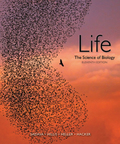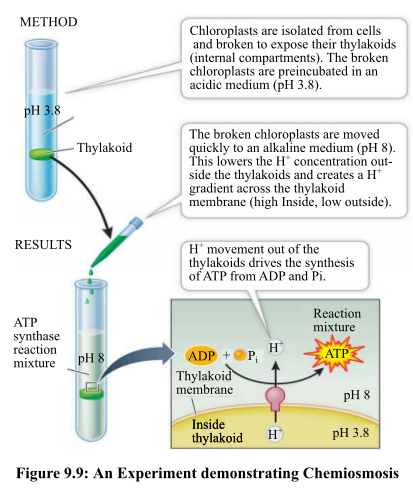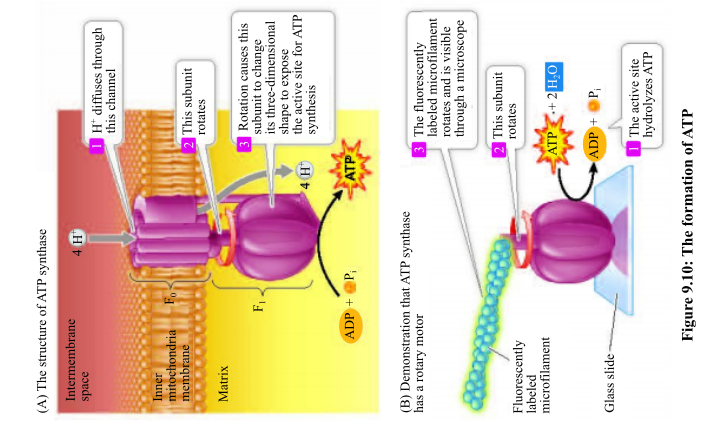
Concept explainers
To review:
The experiments described in Figures 1 and 2, which demonstrate the chemiosmotic mechanism.
Given:

Figure 1: An experiment to demonstrate chemiosmosis.

Figure 2A and B: The formation of adenosine triphosphate (ATP); (A) The structure of ATP synthase and (B) Demonstration that ATP synthase has a rotary motor.
Introduction:
Chemiosmosis is the second stage of the oxidative phosphorylation after the electron transport chain (ETC). As a result of the transport of electrons across the respiratory chain in ETC, a proton concentration gradient takes place to the intermembrane space from the mitochondrial matrix. In chemiosmosis, the production of adenosine triphosphate (ATP) occurs by the influx of the protons back into the matrix of the mitochondria.
Want to see the full answer?
Check out a sample textbook solution
Chapter 9 Solutions
EBK LIFE: THE SCIENCE OF BIOLOGY
- What salt did Meselson and Stahl use for their ultracentrifuge gradients? NaCI NH4CI CSCI O CaCl2arrow_forwardUsing the data in the photo of the two syringes below, answer these six questions: QUESTIONS 1. Which syringe had the most floating disks? Why? 2. What is the gas being released by the leaf disks? 3. Which syringe is the control? 4. Which syringe is the experimental? 5. What is the experimental variable in this experimental design? 6. List at least two controls in this experimental design.arrow_forwardYou got an opportunity to join a professor lab who is working in-vivo model and specifically looking at the dysregulation of mitochondria in liver. He asked you to isolate mitochondria from a Rat liver and placed in an assay medium. Based on the knowledge you gain in this course so far, please answer the following questions: a) Which technique will you use to isolate mitochondria? b) What happens to the pH of the medium when the medium is kept anaerobic? c) What happens when O2-saturated saline is added to the mixture?arrow_forward
- 1 (a)Why is the spectrophotometer set at 0.000 absorbance for the uninoculated tube of broth? (B) Why can't you use the same plot (or standard curve) of plot of absorbance versus cell count for Escherichia coli for other bacteria? (C)List 3 advantages of estimating microbial numbers or biomass by the turbidimetric method? (C)(ii)List 2 disadvantages of this method? (D) Can you measure all kinds of microbes this way? Why not? ( this is not a graded assignment)arrow_forwardwhat is O2BIP? And how does it work?arrow_forwardHow would you design the experiment to determine the CFUs/ml of obligate anaerobic bacterium?arrow_forward
- Describe the outcome of Yanofsky TrpR experiments?arrow_forwardUsing the date in the photo of the two syringes below, answer these six questions: QUESTIONS 1. Which syringe had the most floating disks? Why? 2. What is the gas being released by the leaf disks? 3. Which syringe is the control? 4. Which syringe is the experimental? 5. What is the experimental variable in this experimental design? 6. List at least two controls in this experimental design.arrow_forwardpropose a hypothesis regarding the organism (escherichia, staphylococcus, pseudomonas, bacillus) that will demonstrate greater resistance to UV and why? if the hypothesis is supported, what specific experimental results will be observed? and what serves as the control treatment?arrow_forward
- How are the Kato Katz Technique results reported?arrow_forwardConsider the photos here which demonstrate antibiotic sensitivities of Staphylococcus aureus strains as determined by the Kirby-Bauer method. Abbreviations are as follows: C = chloramphenicol; CC = clindamycin; CZ = cefazolin; E = erythromycin; NOR = norfloxacin; OX = oxacillin; P = penicillin; RA = rifampin; SAM = sulbactam-ampicillin; SXT = sulfatrimethoprim; TE = tetracycline; VA = vancomycin. Imagine that only two cellular changes occurred in the original strain (the first image, on the top) that resulted in the resistance pattern of the strain in the second image (on the bottom). Which combination of mechanisms could explainthese results?Choose one or more: A.expression of efflux pumps B.overproduction of PABA C.production of β-lactamase D.altered penicillin-binding protein E.modification of either 50S or 30S ribosomal subunits F.altered DNA gyrasearrow_forwardIn Exercise 2-1:Ubiquity of Microorganism, we used two unopened plates as controls: one was incubated at 25° C and one was incubated at 37° C. What information do you get from these controls to give you confidence in your results? How does growth on an unopened plate affect the reliability of the other plates that were inoculated in this experiment?arrow_forward
 Principles Of Radiographic Imaging: An Art And A ...Health & NutritionISBN:9781337711067Author:Richard R. Carlton, Arlene M. Adler, Vesna BalacPublisher:Cengage Learning
Principles Of Radiographic Imaging: An Art And A ...Health & NutritionISBN:9781337711067Author:Richard R. Carlton, Arlene M. Adler, Vesna BalacPublisher:Cengage Learning

